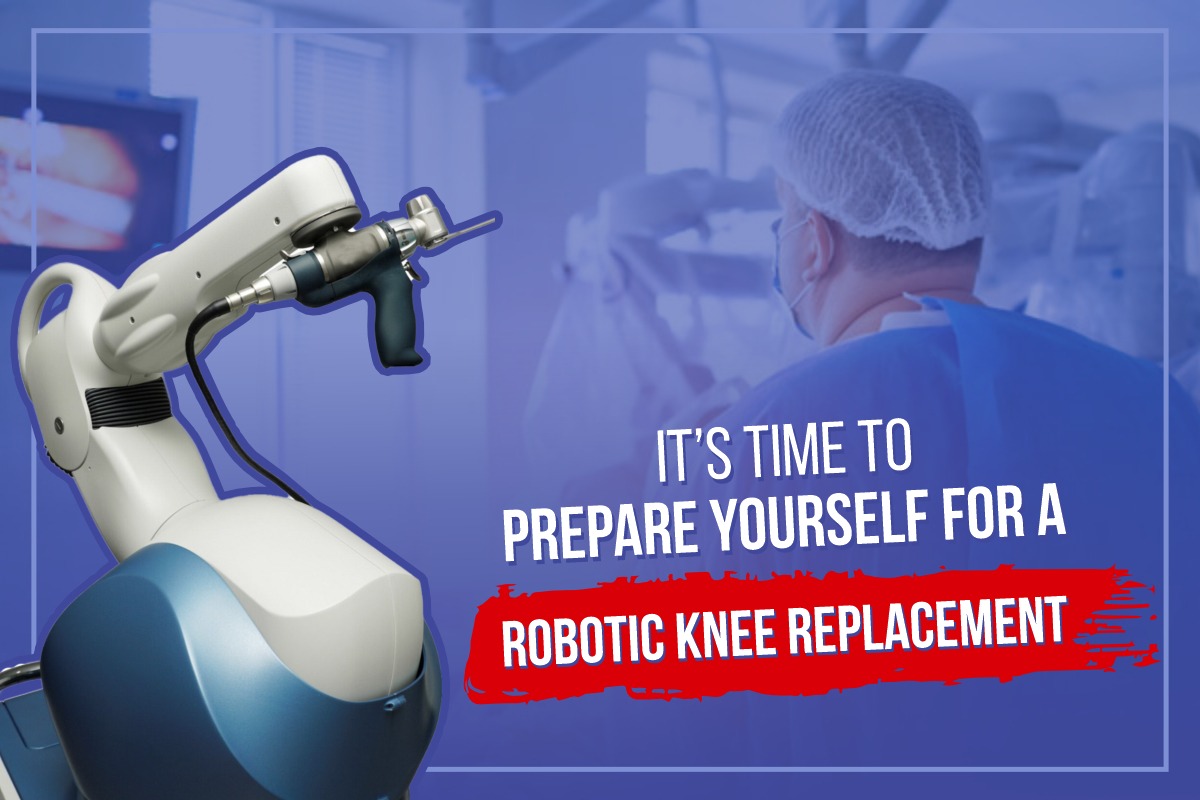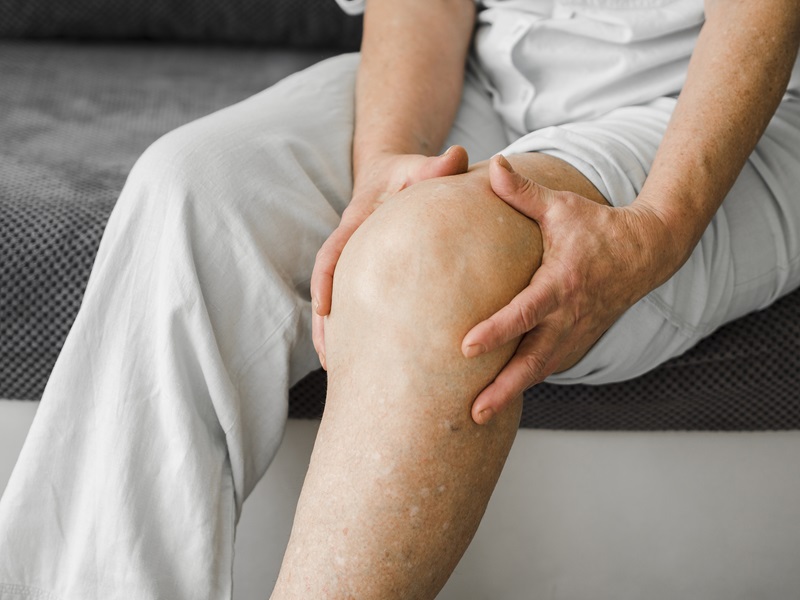It’s time to prepare yourself for a robotic knee replacement

Preparing for robotic knee replacement can feel overwhelming. Many patients wonder about the best ways to prepare for robotic knee replacement surgery, manage pain afterward, and ensure a smooth recovery. So today we are here to address this and more, and share some practical tips, to ensure a faster robotic knee replacement recovery time.
Table of Contents
ToggleSigns That Your Body Needs Knee Arthroplasty
Knee arthroplasty, commonly known as knee replacement surgery, is a procedure to replace a damaged or worn-out knee joint with an artificial implant. Now we do robotic knee replacement surgery that is typically recommended for individuals suffering from severe knee pain, stiffness, or limited mobility due to conditions like:

1. Persistent Pain in Knees
If you’re experiencing ongoing knee pain that doesn’t improve with rest or medication, you’re not alone. Studies show that about 40% of adults with knee osteoarthritis report persistent pain. If this pain disrupts your daily life, then you must Prepare for Robotic knee replacement, a common procedure that can provide significant relief.
2. Swollen and Stiff Knees
These are common signs of arthritis. Research indicates that around 70% of people with knee arthritis experience these symptoms. If these issues prevent you from moving comfortably, it’s essential to consult a specialist, as knee arthroplasty can help restore mobility. Robotic knee replacement recovery time is very quick!
3. The Knee Hurts Even When You Rest
Pain during rest can be a serious concern. Approximately 30% of patients with knee arthritis or knee injuries report pain that worsens at night. This type of discomfort may signal advanced joint problems, making it crucial to seek medical advice and prepare for Robotic knee replacement.
4. Your Leg Structure Bows In or Out
Changes in leg alignment, such as bowing in or out, can affect your knees. Data shows that misalignment can increase the risk of osteoarthritis by up to 50%. If you notice these changes, it’s important to consult a specialist. Robotic knee replacement surgery also helps correct alignment and reduce pain.
Research shows that about 90% of knee replacement patients experience significant pain reduction and improved function. If you desire lasting relief from knee pain, discussing this option with a specialist is essential.
How to get Ready for Robotic Knee Replacement
1. Lose Weight
Studies show that even a modest weight loss of 5-10% can improve surgical outcomes and decrease postoperative complications. This can lead to faster recovery and enhanced mobility. A focused approach to weight management through diet and exercise is advisable. Lower body weight helps you get back to better joint function, leading to a more successful rehabilitation process.
2. Cut Back on Smoking
Research indicates that smokers face higher risks of complications such as infections and delayed recovery after surgery. Quitting smoking at least four weeks before surgery is recommended. This allows your body to improve blood flow and oxygen levels, crucial for healing and shorter robotic knee replacement recovery time.
3. Diet and Hydration in 24 Hours
In the final 24 hours before surgery, it’s crucial to follow specific dietary guidelines. AS you prepare for robotic knee replacement, medical recommendations generally advise eating light, easy-to-digest meals. Staying well-hydrated is essential; however, you should avoid food and drink several hours before the procedure as instructed by your surgeon. Only water may be allowed up to two hours before surgery.
4. Avoid Running or Jogging
To prepare for robotic knee replacement, it’s crucial to avoid high-impact activities like running or jogging. These activities can strain the knee, leading to increased pain and potential injury. Pre-surgery, low-impact exercises such as walking, cycling, or swimming are allowed. These help maintain cardiovascular fitness without stressing the joint.
5. Gentle Exercise Only
Focused exercises, such as straight leg raises and gentle range-of-motion activities, can prepare your body for the surgery. Studies show that patients who adhere to a structured prehabilitation program tend to experience better postoperative outcomes and quicker rehabilitation.
Packing for Robotic Knee Replacement Surgery
1. Dental Care Items
Maintain oral hygiene by packing a toothbrush, toothpaste, and dental floss. After surgery, you might not feel up to a full routine. But basic dental care will prevent discomfort and infections. Studies show that oral health directly impacts overall recovery after any surgery. Consider travel-sized products for convenience.
2. Comfortable, Loose-Fitting Clothes
Breathable fabrics like cotton allow for ease of movement and help regulate body temperature, which is crucial for recovery. A study published in the Journal of Clinical Nursing emphasises that comfortable clothing can enhance patient satisfaction and promote a positive recovery experience. Aim for items that can accommodate knee swelling post knee replacement.
3. Knee-Length Robe and Slip-On Shoes
A knee-length robe offers comfort and ease during your hospital stay. Slip-on shoes are recommended for mobility; for easy dressing and movement post-surgery. Research indicates that comfortable footwear reduces the risk of falls. Look for options with a non-slip sole to ensure safety.
4. Cell Phone (Optional)
According to a study in Health Communication, maintaining social connections can enhance recovery outcomes. It allows you to stay connected with family and friends, which can be beneficial for emotional support.
5. ID (Aadhar Card, Driver’s License or Passport)
Pack a form of identification, as it is always required for hospital admission. Proper identification helps streamline the check-in process and ensures accurate medical records.
What to Expect the Day Before and on the Day of Robotic Knee Replacement Surgery
1. The Day Before Surgery
Patients typically need to fast after midnight to minimise the risk of complications; WHO states that fasting significantly reduces the risk of aspiration during surgery. Medication reviews with the surgeon are essential, as about 30% of patients on anticoagulants may need adjustments to reduce bleeding risks. Mental and emotional readiness is also important; techniques like deep breathing can help ease anxiety. Studies indicate that preoperative mental preparation improves outcomes by 20%, making this day critical for both physical and emotional well-being.
2. The Day of Surgery
You must arrive early at the hospital for check-in and final evaluations. This allows for necessary preoperative assessments. These include checking your vital tests and discussions about anaesthesia options, which are crucial for comfort. The knee replacement procedure generally lasts 1 to 2 hours. According to WHO, about 80-90% of patients report improved function post-surgery. Effective surgical technique significantly impacts long-term outcomes, with studies showing a 90% success rate for proper alignment of knee.
After Robotic Knee Replacement Surgery Care
1. Ice Your Knee
According to the World Health Organization (WHO), effective pain management is crucial for recovery. A study in The Journal of Bone and Joint Surgery found that patients who used ice therapy experienced a 30% reduction in postoperative pain within the first 48 hours. Ice should be applied for 15-20 minutes every hour during the first few days after surgery to maximise its benefits.
2. Elevate Your Knee
The WHO suggests that elevation, combined with ice, can decrease swelling and improve circulation. A clinical trial published in Physiotherapy Research International reported that patients who elevated their knees consistently had 25% less swelling compared to those who did not. Keeping the knee elevated above heart level, especially during the first few days, is recommended for faster robotic knee replacement recovery time.
3. Keep Your Incision Clean and Covered
Maintaining a clean and covered incision (cut) is extremely crucial for preventing any kind of infection. The WHO emphasizes that surgical site infections can occur in 1-3% of patients post-knee surgery. Proper wound care, including cleaning with mild soap and covering with a sterile dressing, is essential for proper after robotic knee replacement care.
4. Home Exercises
Early mobilisation can lead to better functional outcomes. A randomised controlled trial in Archives of Physical Medicine and Rehabilitation showed that patients who began home exercises within 48 hours of surgery improved their range of motion by 30% more than those who delayed exercise. Following a structured exercise plan can enhance recovery significantly.
5. PhysioTherapy
Research indicates that patients who participate in physiotherapy achieve better outcomes and faster robotic knee replacement recovery time. Patients who undergo physical therapy usually report a 40% improvement in function by six weeks post-surgery, due to better blood circulation and less chances of stiffness.
We hope that we have prepared you enough to take the next step. But if you still have more queries, you can always write to us or contact us. We assure you that we will help you start your journey toward better mobility and your future self will thank you!






